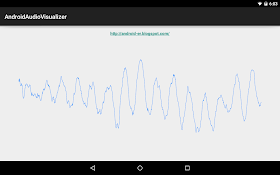remark@2016-10-18:
I found that the example code removed from Android Studio examples list, may be it is NOT work now.
Create custom VisualizerView extends View, VisualizerView.java
package com.example.androidaudiovisualizer;
import android.content.Context;
import android.graphics.Canvas;
import android.graphics.Color;
import android.graphics.Paint;
import android.graphics.Rect;
import android.util.AttributeSet;
import android.view.View;
public class VisualizerView extends View {
private byte[] mBytes;
private float[] mPoints;
private Rect mRect = new Rect();
private Paint mForePaint = new Paint();
public VisualizerView(Context context) {
super(context);
init();
}
public VisualizerView(Context context, AttributeSet attrs) {
super(context, attrs);
init();
}
public VisualizerView(Context context, AttributeSet attrs, int defStyleAttr) {
super(context, attrs, defStyleAttr);
init();
}
private void init() {
mBytes = null;
mForePaint.setStrokeWidth(1f);
mForePaint.setAntiAlias(true);
mForePaint.setColor(Color.rgb(0, 128, 255));
}
public void updateVisualizer(byte[] bytes) {
mBytes = bytes;
invalidate();
}
@Override
protected void onDraw(Canvas canvas) {
super.onDraw(canvas);
if (mBytes == null) {
return;
}
if (mPoints == null || mPoints.length < mBytes.length * 4) {
mPoints = new float[mBytes.length * 4];
}
mRect.set(0, 0, getWidth(), getHeight());
for (int i = 0; i < mBytes.length - 1; i++) {
mPoints[i * 4] = mRect.width() * i / (mBytes.length - 1);
mPoints[i * 4 + 1] = mRect.height() / 2
+ ((byte) (mBytes[i] + 128)) * (mRect.height() / 2) / 128;
mPoints[i * 4 + 2] = mRect.width() * (i + 1) / (mBytes.length - 1);
mPoints[i * 4 + 3] = mRect.height() / 2
+ ((byte) (mBytes[i + 1] + 128)) * (mRect.height() / 2)
/ 128;
}
canvas.drawLines(mPoints, mForePaint);
}
}
Add <com.example.androidaudiovisualizer.VisualizerView> to layout file, activity_main.xml.
<LinearLayout xmlns:android="http://schemas.android.com/apk/res/android"
xmlns:tools="http://schemas.android.com/tools"
android:layout_width="match_parent"
android:layout_height="match_parent"
android:orientation="vertical"
android:paddingBottom="@dimen/activity_vertical_margin"
android:paddingLeft="@dimen/activity_horizontal_margin"
android:paddingRight="@dimen/activity_horizontal_margin"
android:paddingTop="@dimen/activity_vertical_margin"
tools:context="com.example.androidaudiovisualizer.MainActivity" >
<TextView
android:layout_width="wrap_content"
android:layout_height="wrap_content"
android:layout_gravity="center_horizontal"
android:autoLink="web"
android:text="http://android-er.blogspot.com/"
android:textStyle="bold" />
<com.example.androidaudiovisualizer.VisualizerView
android:id="@+id/myvisualizerview"
android:layout_width="match_parent"
android:layout_height="match_parent" />
</LinearLayout>
MainActivity.java
package com.example.androidaudiovisualizer;
import android.support.v7.app.ActionBarActivity;
import android.media.AudioManager;
import android.media.MediaPlayer;
import android.media.audiofx.Visualizer;
import android.os.Bundle;
/*
* Copy test.mp3 to /res/raw/ folder
*
* needed in AndroidManifest.xml
* android:minSdkVersion="9"
* uses-permission of "android.permission.RECORD_AUDIO"
*
* reference: Android demo example -
* ApiDemos > Media > AudioTx
*/
public class MainActivity extends ActionBarActivity {
VisualizerView mVisualizerView;
private MediaPlayer mMediaPlayer;
private Visualizer mVisualizer;
@Override
protected void onCreate(Bundle savedInstanceState) {
super.onCreate(savedInstanceState);
setContentView(R.layout.activity_main);
mVisualizerView = (VisualizerView) findViewById(R.id.myvisualizerview);
initAudio();
}
@Override
protected void onPause() {
super.onPause();
if (isFinishing() && mMediaPlayer != null) {
mVisualizer.release();
mMediaPlayer.release();
mMediaPlayer = null;
}
}
private void initAudio() {
setVolumeControlStream(AudioManager.STREAM_MUSIC);
mMediaPlayer = MediaPlayer.create(this, R.raw.test);
setupVisualizerFxAndUI();
// Make sure the visualizer is enabled only when you actually want to
// receive data, and
// when it makes sense to receive data.
mVisualizer.setEnabled(true);
// When the stream ends, we don't need to collect any more data. We
// don't do this in
// setupVisualizerFxAndUI because we likely want to have more,
// non-Visualizer related code
// in this callback.
mMediaPlayer
.setOnCompletionListener(new MediaPlayer.OnCompletionListener() {
public void onCompletion(MediaPlayer mediaPlayer) {
mVisualizer.setEnabled(false);
}
});
mMediaPlayer.start();
}
private void setupVisualizerFxAndUI() {
// Create the Visualizer object and attach it to our media player.
mVisualizer = new Visualizer(mMediaPlayer.getAudioSessionId());
mVisualizer.setCaptureSize(Visualizer.getCaptureSizeRange()[1]);
mVisualizer.setDataCaptureListener(
new Visualizer.OnDataCaptureListener() {
public void onWaveFormDataCapture(Visualizer visualizer,
byte[] bytes, int samplingRate) {
mVisualizerView.updateVisualizer(bytes);
}
public void onFftDataCapture(Visualizer visualizer,
byte[] bytes, int samplingRate) {
}
}, Visualizer.getMaxCaptureRate() / 2, true, false);
}
}
Next example:
- Visible DTMF Piano: Visualizer + ToneGenerator

Works perfectly. Thanks !!
ReplyDeletePerfect !!!
ReplyDeletePlease show me how to use this on voice recorder (Android MediaRecorder) while I'm recording voice.
ReplyDeleteThank you for Share it.
ReplyDeleteThank you very much.
Works fine!
ReplyDeleteIn Android 6.0 I had to ask for this permissions in the code to start working
if( ContextCompat.checkSelfPermission(this, Manifest.permission.MODIFY_AUDIO_SETTINGS) == PackageManager.PERMISSION_GRANTED){
}else{
ActivityCompat.requestPermissions(this,
new String[]{Manifest.permission.MODIFY_AUDIO_SETTINGS},
MY_PERMISSIONS_REQUEST_MODIFY_AUDIO_SETTINGS);
}
if( ContextCompat.checkSelfPermission(this, Manifest.permission.RECORD_AUDIO) == PackageManager.PERMISSION_GRANTED){
}else{
ActivityCompat.requestPermissions(this,
new String[]{Manifest.permission.RECORD_AUDIO},
MY_PERMISSIONS_REQUEST_RECORD_AUDIO);
}
Can you create a vertical bar style for this ?
ReplyDeleteBehind that, great tutorial and example +1
Error code -1 when initializing Visualizer
ReplyDeletePlease show me how to use this on voice recorder (Android MediaRecorder) while I'm recording voice.
ReplyDeleteThanks before, because it's works perfectly!!
ReplyDeletebut it's just for one audio, how can make it work for more audio??
Hi~! This a great tutorial and working. Can this be possible for a bar graph?
ReplyDelete@ardi nada on MediaPlayer setOnCompletionListener call mVisualizer.setEnabled(false)
@anddev thx !! it's work!!
ReplyDeletebut now i get new question, why when i use this visualizer, i cant use audio effect like BassBoost??
I'm on android 6.0, when I try to run the app it just tells me 'Unfortunately, audioVisualizer has closed". I gave it the mic permission in my settings. The only thing that I think maybe went wrong with inputting the code was the part at the very top that says something about reference Android demo example: ApiDemos > Media > AudioTx. I don't know what I am supposed to do about that. Any ideas anyone? Thanks!
ReplyDeleteremark@2016-10-18:
ReplyDeleteI found that the example code removed from Android Studio examples list, may be it is NOT work now.
Sumit Naharia It's a permission problem, see here: http://stackoverflow.com/a/28427213
ReplyDeleteJust add the following to your app manifest xml:
Hi! I get this error on Android 6.0 (LG Spirit):
ReplyDeleteCannot initialize Visualizer engine, error: -3
Thanks for the post works like a charm
ReplyDeleteandroid:paddingBottom="@dimen/activity_vertical_margin"
ReplyDeleteandroid:paddingLeft="@dimen/activity_horizontal_margin"
android:paddingRight="@dimen/activity_horizontal_margin"
android:paddingTop="@dimen/activity_vertical_margin"
tools:context="com.example.androidaudiovisualizer.MainActivity" >
what is this? These things keep ocurring errors.... what to do?
hello Alien LB,
ReplyDeleteYou can remove it.
Still its not working...
ReplyDeleteandroid.view.InflateException: Binary XML file line #20: Binary XML file line #20: Error inflating class com.example.androidaudiovisualizer.VisualizerView
i am getting this kind of error..
please can anyone help me..
I also won't able to run.Please anyone can help.How to connect music with visualizer in order to get effect of high note and low note.
ReplyDeleteHey,
ReplyDeleteThanks for an amazing tutorial. Although while running the application I am facing a run time exception. java.lang.RuntimeException: Cannot initialize Visualizer engine, error: -1 .
After installation, the permission section of the application doesn't have "Audio" related permissions. Please help me with this.
How to apply that in a "vertical-bars" way?
ReplyDelete